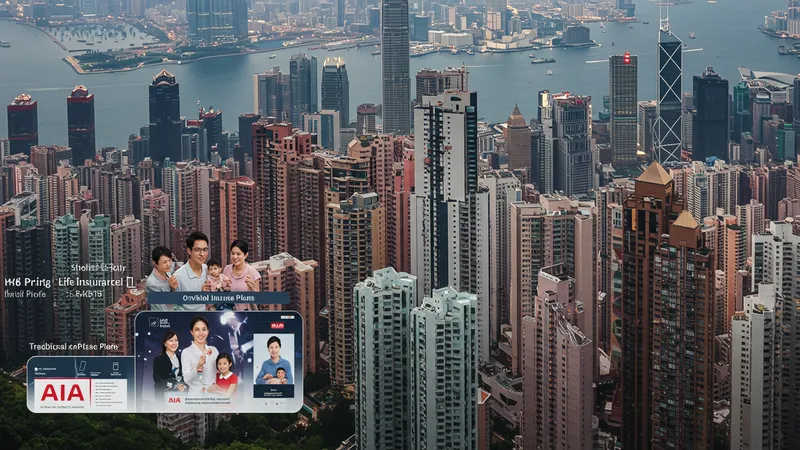

In a dynamic region like Hong Kong, the insurance sector serves as a vital pillar for both individuals and businesses. Insurance services here do far more than mitigate risk—they underpin property transactions, facilitate global commerce, and provide residents with unique peace of mind against uncertain events. Exploring insurance services and the evolving market landscape in Hong Kong reveals how local practices, global influences, and regulatory requirements converge to shape choices and competition.
The insurance landscape in Hong Kong is characterized by diversity and innovation. From traditional life and health insurance to sophisticated business and marine policies, the industry adapts quickly to emerging demand. Backed by a robust regulatory environment and international connectivity, Hong Kong's insurance market attracts global brands and fosters home-grown innovation, giving consumers access to a wide variety of products.

Hong Kong’s insurance services cater to a unique blend of local and international demands. For instance, AIA Life Insurance specializes in legacy and savings plans suitable for both local families and expat professionals. Insurers such as Manulife, BOC Life, and AXA offer product suites that stitch together classic coverage types and innovative add-ons, tailored to the region’s demographic profile and urban lifestyle.
The regulatory regime under Hong Kong’s Insurance Authority ensures exceptional security and transparency for policyholders. Insurers must adhere to strict solvency requirements and consumer protection standards, which fosters market confidence and encourages product evolution. This environment has spurred international players to enter—and thrive—within the territory.
Premiums in Hong Kong’s insurance market reflect global standards, yet some services are distinctly tuned to local realities. Factors such as urban density, high property valuation, and cross-border activity shape both insurance needs and product design. For example, travel and motor insurance options are robust, reflecting the city’s status as a regional transit hub and a financial centre with a highly mobile population.
Recent years have also spotlighted digital transformation within Hong Kong’s insurance sector. Whether securing a policy online, managing claims via mobile apps, or using AI-driven tools for pricing, tech integration enhances convenience and accessibility for consumers and businesses alike. The next few pages plunge deeper into these service categories, revealing how they drive competition and cater to the city’s distinct expectations. The deeper details reveal even more valuable insights ahead…
Life insurance forms the cornerstone of personal financial planning in Hong Kong’s insurance market. AIA Life Insurance, for example, delivers a portfolio that mixes traditional whole and term life insurance with savings-oriented plans. Many residents in Hong Kong see life insurance as an intergenerational asset-transfer tool, influenced by local inheritance practices and competitive rates. Such products often feature riders that increase flexibility and customization, a valued trait among the city’s diverse population.

The pricing for life insurance in Hong Kong is generally competitive, with premiums being notably lower for younger policyholders. The market also embraces hybrid policies blending life coverage with investment-linked components, such as AIA’s participating plans. This trend reflects the robust demand for savings vehicles within insurance, tailored for both long-term accumulation and family security.
Foreign insurers bring competitive propositions and robust claims management, but local firms may offer advantages in regional know-how and localized benefits. For instance, local distributors and brokers provide insight into Hong Kong-specific risks, such as high property exposure or cross-border family structures. Both local and international options adapt swiftly to regulatory updates and consumer preferences.
As digitalization advances, Hong Kong’s life insurance sector increasingly utilizes online portals for product comparisons and policy administration. Virtual advisors or digital application processes are commonplace, expanding accessibility for busy urban dwellers and young professionals. The city’s emphasis on transparency and service quality is evidenced by the popularity of instant quotes, interactive calculators, and easily accessible policy documentation, all of which are designed to cater to the market’s sophisticated requirements.
Health insurance in Hong Kong, offered by companies like Manulife, plays a central role due to the city’s high medical costs and reliance on private healthcare options. Notably, products in this segment often include comprehensive hospitalization, outpatient, and maternity packages. Corporate health insurance is also prevalent, as employers prioritize competitiveness by supporting staff well-being through group health plans and tailored employee benefits.

Critical illness insurance, exemplified by BOC Life’s offerings, has gained traction as public awareness of long-term health challenges rises. These products generally provide lump-sum payouts on the diagnosis of serious medical conditions, helping insureds maintain financial stability during recovery periods. Hong Kong’s insurers regularly update their coverage to reflect shifting health trends and to ensure broad protection across a wide range of illnesses.
Corporate insurance by providers like FWD introduces flexibility for businesses of all sizes. Multifaceted business insurance packages cover property, liability, key personnel, and employee-related risks, which supports Hong Kong’s thriving SME and multinational landscape. Such plans can be customized to match industry-specific risks, from retail operations to global logistics firms headquartered in the city.
This sector is also moving toward digital convenience, with insurers launching user-friendly employer portals and health claims apps. These advancements accelerate claims processing and increase transparency, which are highly valued in the fast-paced business environment of Hong Kong. With rising demand for proactive health management, many insurers offer wellness programs and incentives, integrating health coverage with preventative care strategies.
Home insurance, offered by providers like Prudential, protects one of Hong Kong’s most significant assets—real estate. With high-density living and soaring property values, residents are keenly aware of the need for robust coverage against risks such as fire, water damage, and theft. Special features like personal liability protection and emergency home assistance are commonly built into these policies, reflecting the demands of urban lifestyles and property market dynamics.

Motor insurance solutions by HSBC respond to Hong Kong’s stringent regulatory environment. Compulsory third-party liability is the baseline, but comprehensive plans that include accidental damage, theft, and personal accident cover are popular among private vehicle owners. Given the city’s limited parking and heavy road use, insurers pay close attention to swift claims settlement and roadside support.
Travel insurance through international brands such as AXA is in high demand in Hong Kong, a major travel and business hub. Policies frequently provide extensive worldwide coverage, catering to residents who travel for leisure or business. Standard benefits often encompass medical expenses abroad, trip interruption, and lost baggage, while certain plans offer specialized coverage for adventure travel and high-value personal belongings.
Hong Kong’s insurance sector stands out for its service efficiency and claims responsiveness. Digital claims submission and multilingual support are standard across most property, motor, and travel policies. This approach not only improves brand reputation but also supports rapid mobility and resilience in the face of unplanned events, both within the city and internationally.
Hong Kong’s Insurance Authority shapes a trusted and adaptive environment for insurers and consumers alike. Stringent licensing procedures and continuous monitoring help preserve market stability. These regulations ensure companies like AIA, Manulife, and AXA maintain adequate reserves, transparent product disclosures, and fair claims practices, creating confidence among local and international policyholders.

Recent years have seen a shift in consumer expectations, with digital platforms and tele-advisory services taking centre stage. Online comparison sites and insurer apps empower consumers to scrutinize products side by side, accelerating competitive innovation. Features like instant policy issuance and digital customer service are now baseline criteria for leading providers in Hong Kong.
Hong Kong’s insurance providers also respond proactively to demographic trends, such as population ageing and the rise of high-net-worth individuals. Insurers develop products that reflect these realities, like savings-linked life insurance and extended critical illness plans. The city’s pivotal position in Greater Bay Area integration also influences insurers to introduce cross-border policy benefits for travellers and expatriates.
Looking forward, greater technology integration is expected to redefine the insurance customer experience in Hong Kong. Artificial intelligence, big data, and blockchain are already being piloted for risk assessment, fraud prevention, and policy administration. These advancements underscore the ongoing transformation of the insurance sector, setting new benchmarks in both consumer choice and operational efficiency.